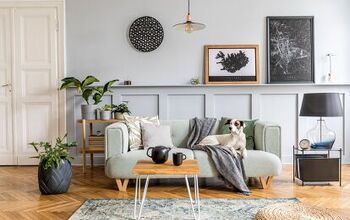Non-Negotiable Design Mistakes: Trends To Avoid At All Costs

The world of interior design is full of matters of opinion, from trending colors to the latest furniture and decor. Some choices tend to work better than others, but it doesn’t mean that you can’t go against the grain. However, some design mistakes are exactly that — mistakes, and they don’t quite seem to work well no matter what the situation.
Cramming too much into a space so that it’s difficult to move around and ignoring clearances between elements are two big design mistakes. Using mixed lighting color temperatures, materials that don’t make sense for your lifestyle, and putting carpet in a bathroom are other no-nos. Don’t skip measuring items or testing colors, and position elements comfortably in the space.
Overall, the most important part of designing your home is choosing pieces that speak to you. Your style should reflect your personality and work well for your lifestyle, not copy and paste the latest Pinterest board. However, no matter what the current trends or your style, there are a few things that remain design taboos.
10 Design Choices That Don’t Work In Any Space
Go wild when you design your home, and choose things that you love, no matter what the latest design magazine tells you. But, it’s worth checking out these no-nos when it comes to design. Although most design choices are ultimately a matter of opinion, the following things don’t do your space any favors.
1. Using Too Much Furniture Or Furniture That’s Too Big
Pay attention to the spacing between your furniture. When there’s too much furniture or pieces are overly large for the scale of the room, you lose valuable negative space needed for optimal flow.
If there isn’t enough room to move around comfortably, the space becomes awkward and uncomfortable. Leave between 18 and 24 inches between furniture pieces to create an easy flow through the room.
If you’re working with an extremely small space, it’s possible to go down to 14 inches between select pieces. However, keep in mind the less space people have to maneuver, the more likely they are to feel cramped.
2. Mismatching The Color Temperature Of Your Lighting
Lighting has a certain color temperature depending on the bulb you use. This is why you get a warmer, more yellow tone with some lights and a brighter, white light with others. It’s a matter of personal preference whether you like warmer or cooler lighting.
However, the design choice that never works well is to mix different color temperatures in one space. For example, imagine having a more yellow, warm bulb in one lamp and putting a bright, daylight bulb in the ceiling fixture. This variation in color temperature creates a disjointed look that can really throw off the whole feel of the room.
3. Not Paying Attention To Clearances In The Space
We mentioned having adequate spacing between your furniture, but that isn’t the only place to think about clearance. Another awkward and frustrating design dilemma is when you don’t have the proper clearance for various components to function properly.
A few examples are a drawer that can’t open if a nearby cabinet is open at the same time. Or a dishwasher, oven, or refrigerator you can’t open because they’re too close to a drawer or door.
And these problems aren’t isolated to the kitchen. It can also happen in the bathroom, with doors that won’t open fully because of their proximity to the toilet. Or in a bedroom, when you can’t open your closet if your bedroom door is open.
All of these represent design mistakes that come down to poor planning, and they’re likely never intentional. However, intentional or not, it’s easy to agree they don’t work well.
4. Failing To Consider Your Habits And Lifestyle When Choosing Materials
A big non-negotiable design mistake is choosing materials and items for your space strictly based on the latest trends instead of how you live your life. If you pick pieces that don’t complement your lifestyle, it’s not going to end well for you.
For example, if you have bad allergies and decide to install shag carpeting in every room, you’ll soon regret it. Multiple studies suggest that carpet increases indoor allergens. Likewise, if you have pets, it’s best to choose durable materials that are easy to maintain and clean.
Large-format tiles in a shower tend to create a slippery surface, and hardwood floors and certain wallpapers in a bathroom don’t react well to the humidity. Basically, do your research, consider your lifestyle, and make sure to choose materials that make sense and work well for their application.
5. Putting Carpet In A Bathroom
Wall-to-wall carpeting in a bathroom doesn’t make sense when you really think about it. Although a popular choice back in the day (way back in the day), nowadays, people recognize this is not the best choice. It’s simply not practical, and the problems it causes make it a big design mishap.
Carpet and moisture don’t mix, and bathrooms typically create a lot of moisture. This means carpet in a bathroom becomes highly susceptible to mold and mildew. (Not to mention lots of stains from make-up, shaving cream, and other toiletry items.) If you want something soft and warm under your feet, choose a durable bath mat or rug that’s easy to toss into the washing machine.
6. Always Choosing Form Over Function (In Every Single Room)
The core element of good design is creating a seamless, beautiful blend of form and function. Therefore, if you make all your choices strictly based on how things look, it’s likely to lead to several issues.
If you have a formal living room you only use twice a year, then perhaps going full-on isn't so bad. But for the majority of the pace in your home, function matters. In some cases, you might create a space that looks beautiful but isn’t very comfortable. This combination isn't ideal for spaces like a family room or bedroom.
Also, if you ignore function completely, it could lead to several hazards. For example, hanging curtains in front of baseboard heaters, or putting large furniture directly in front of HVAC vents.
7. Hanging Artwork Or Televisions Too High
Have you ever sat down to watch a movie and had to crane your neck way back and thought, “Gee, this is swell?” No? Yeah, thought so. That’s because people like to be comfortable, and television or artwork hung too high can hurt your neck.
The ideal position for artwork is to hang the center at eye level of the average person (roughly 57 inches). So, if you’re 6’5”, don’t base the position on your eye level.
For televisions, the average hanging height for the center of the TV is 40 inches from the floor. However, you can adjust this down or up a couple of inches depending on your viewing preference.
8. Not Measuring Items Before You Buy
It’s happened to the best of us. You see a stunning sofa on the furniture store’s showroom floor and simply must have it. You buy it, bring it home, and realize it doesn’t fit. But it looked so perfect in the store.
Failing to measure your space and the pieces you buy usually ends up being a mistake. Plus, things always look smaller than they actually are when you see them in a big showroom. Always measure before you buy.
If you’re really struggling to decide if a particular piece will fit in your space, use masking tape to mark the measurements on the floor. This trick helps you get a better picture of how a new piece will fit with your other furniture. There are also space planning tools you can use online, like RoomSketcher🄬.
9. Skipping Color Samples
Similar to skipping taking measurements when designing your space is foregoing using color samples. Don’t choose paint colors solely based on how the little paper paint chip looks. Instead, purchase sample jars of paint for roughly $4 or $5 to test out the color in your space.
Paint a piece of illustration or poster board so you can move it around the room. Then you can see how the color looks in different positions and under different lighting.
Do the same thing for tiles, wallpaper, countertops, cabinets, flooring, and carpet. Performing this extra step of testing samples will end up saving you money and time in the long run.
10. Ignoring Design Flow Between Spaces
When designing a room in your house, you’d be remiss to not consider the design choices in the rest of your home. Although all of your rooms don’t need to match or reflect the same exact style, they shouldn’t be completely disjointed from each other. You do want to have an overall feeling of balance throughout your home.
As you design a space, make sure to consider the other rooms in your house and choose elements that tie the spaces together. When you create a cohesive home, you’ll feel an overall sense of peace, and you’ll enjoy your home more.
Design Trends Aren’t Always The Right Choice
You’ll never escape trends when it comes to interior design. After all, trends are often what make the design world go round. But a staple of fabulous design is making your space feel like you and fit your lifestyle. However, varying opinions and preferences aside, there are some things that never really make sense, no matter what your style.
Take the time to plan, measure, and test color samples when you design your space. Consider the other rooms in your home, and choose items that make sense for your lifestyle and that function well.
Overall, you want a sense of balance and flow that pulses through your entire home. And if you’re happy at home, then you’ve scored a huge design win.
Related Guides:

Stacy Randall is a wife, mother, and freelance writer from NOLA that has always had a love for DIY projects, home organization, and making spaces beautiful. Together with her husband, she has been spending the last several years lovingly renovating her grandparent's former home, making it their own and learning a lot about life along the way.
More by Stacy Randall













![The 5 Best Angle Grinders – [2022 Reviews & Buyer's Guide]](https://cdn-fastly.upgradedhome.com/media/2023/07/31/9071326/the-5-best-angle-grinders-2022-reviews-buyer-s-guide.jpg?size=350x220)













